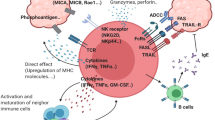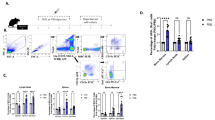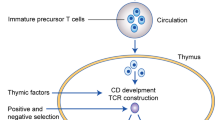Abstract
T-cell clones that grow continuously in tissue culture have become a major tool for studying the properties of T lymphocytes. It is therefore important to know to what extent such clones resemble their normal counterparts. Several reports have appeared recently which demonstrate that long-term T-cell lines may lose the specificity for which they were initially selected and acquire cytotoxic activity to a variety of targets, typical of the activity displayed by natural killer cells1–3. We now report a number of instances in which murine cytotoxic T-cell clones have lost their original specific cytotoxic activity but have acquired strong specific cytotoxic activity for P815 mastocytoma target cells. Loss of the original specificity was usually observed after continuous in vitro cultivation for more than 6 months. We propose that this novel type of cytotoxicity should be called aged killer activity.
This is a preview of subscription content, access via your institution
Access options
Subscribe to this journal
Receive 51 print issues and online access
$199.00 per year
only $3.90 per issue
Buy this article
- Purchase on Springer Link
- Instant access to full article PDF
Prices may be subject to local taxes which are calculated during checkout
Similar content being viewed by others
References
Hengartner, H. et al. in NK Cells and Other Natural Effector Cells (ed. Herbermann, R. E.) 893–902 (Academic, New York, 1982).
Brooks, C. G., Karibojashi, K., Sale, G. E. & Henney, C. J. Immun. 128, 2326–2335 (1982).
Binz, H., Fenner, M., Frei, D. & Wigzell, H. J. exp. Med. 157, 1252–1260 (1983).
v.Boehmer, H., Haas, W., Pohlit, H., Hengartner, H. & Nabholz, M. Springer's Sem. Immunopath 3, 23–49 (1980).
Glasebrook, A. L. et al. Immun. Rev. 54, 225–266 (1981).
v.Boehmer, H. et al. Eur. J. Immun. 9, 592–597 (1979).
Kanagawa, O., Louis, J. & Cerottini, J. C. J. Immun. 128, 2362–2366 (1982).
Lindahl, K. F., Nordin, A. A. & Schreier, M. H. in T Cell Hybridomas (eds v.Boehmer, H., Haas, W., Köhler, G., Melchers, F. & Zeuthen, M.) 1–10 (Springer, Berlin, 1982).
Nakayama, E., Shiku, H., Stockert, E., Oettgen, H. F. & Old, L. Proc. natn. Acad. Sci. U.S.A. 76, 1977–1981 (1979).
Möller, G. (ed.) Immun. Rev. 68, 5–218 (1982).
Shortman, K., Wilson, A., Scollay, R. & Chen, W. F. Proc. natn. Acad. Sci. U.S.A. 80, 2728–2732 (1983).
Author information
Authors and Affiliations
Rights and permissions
About this article
Cite this article
Simon, M., Weltzien, H., Bühring, H. et al. Aged murine killer T-cell clones acquire specific cytotoxicity for P815 mastocytoma cells. Nature 308, 367–370 (1984). https://doi.org/10.1038/308367a0
Received:
Accepted:
Issue Date:
DOI: https://doi.org/10.1038/308367a0
This article is cited by
-
Mammalian T-lymphocyte antigen receptor genes: genetic and nongenetic potential to generate variability
Human Genetics (1987)
-
Virus-immune T cells and the major histocompatibility complex: Evolution of some basic concepts over the past two years
Experientia (1986)
-
A highly homologous T-cell receptor ?-chain variable region is expressed in mouse and human T cells
Immunogenetics (1985)
Comments
By submitting a comment you agree to abide by our Terms and Community Guidelines. If you find something abusive or that does not comply with our terms or guidelines please flag it as inappropriate.



